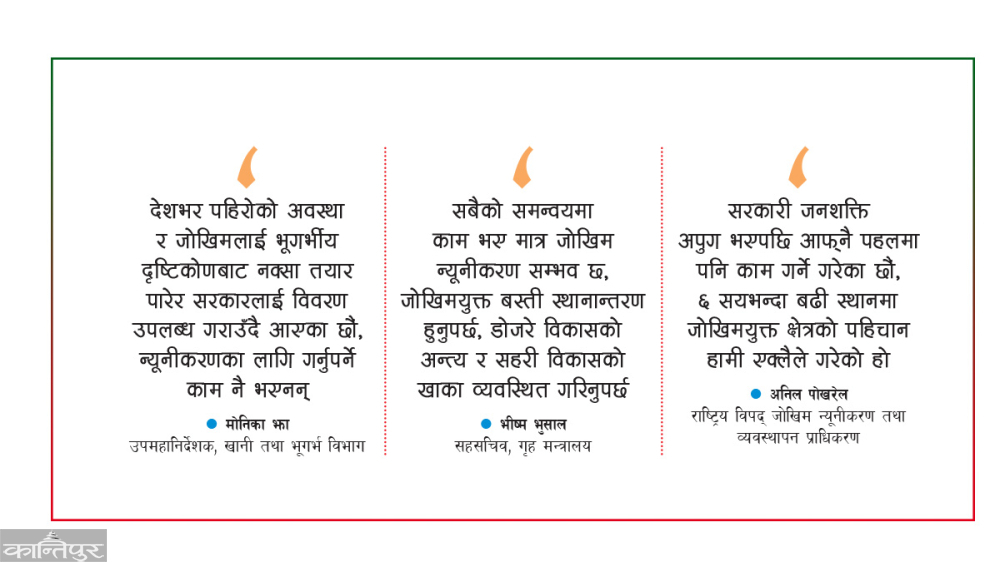In 10 years, 1800 people lost their lives due to floods, landslides and inundation

We use Google Cloud Translation Services. Google requires we provide the following disclaimer relating to use of this service:
This service may contain translations powered by Google. Google disclaims all warranties related to the translations, expressed or implied, including any warranties of accuracy, reliability, and any implied warranties of merchantability, fitness for a particular purpose, and noninfringement.

Highlights
- This year, 88 people died within 1 month of the monsoon, the government's response plan to deal with the disaster was not effective, and the loss of property during the rainy season increased.



More than 1,800 people have lost their lives in a decade due to monsoon disasters. During this period, about 400 people went missing and more than 1,500 people were injured in the disaster. Every year, unimaginable loss of human wealth is caused by calamities such as fire/fire, snow and dry landslides in winter and floods, landslides and inundation in rainy season.

Since the government's response plan to deal with disasters is not effective, this problem is recurring especially during the rainy season. Just before the monsoon, the response plan brought by the government in a hurry is limited to search and rescue and relief management only. The government is not serious about formulating action plans with long-term and policy reforms.
Since the onset of monsoon this year, 88 people have lost their lives due to floods, landslides and drowning. Some of the damages have been caused by the failure of the government to take initiative in the beginning. Whether it is the management of settlements encroached on river banks or the relocation of settlements at risk from floods and landslides, the government's initiatives have not been effective in these works.
Landslides especially in Himalayan and hilly regions and floods and inundation in Terai/Madhes including Kathmandu valley have caused loss of human wealth every year. According to the Ministry of Home Affairs, since 2072, 1 thousand 848 people have died due to disasters. 398 people are still missing.
 Last year 70 people lost their lives in the disaster. This time since the onset of monsoon, the loss of human life is more than last year. Even though the experts warned early that the incidence of disasters may increase with the prediction that there will be more rains than before, the action plan could not be implemented accordingly. In a decade, not only the loss of human life, but also the loss of property by the general public is dire.
Last year 70 people lost their lives in the disaster. This time since the onset of monsoon, the loss of human life is more than last year. Even though the experts warned early that the incidence of disasters may increase with the prediction that there will be more rains than before, the action plan could not be implemented accordingly. In a decade, not only the loss of human life, but also the loss of property by the general public is dire.
Floods, landslides and inundation-related disasters have destroyed property worth 2.6 billion 76 million rupees during this period. According to the data of the National Emergency Operation Center under the Ministry of Home Affairs, 7.7 million families have been directly/indirectly affected by 21,500 disaster incidents in a decade.
In the year 2077, the maximum number of 358 people lost their lives due to disasters. Bhishma Kumar Bhusal, head of the Disaster Management Division of the Ministry of Home Affairs, says that landslides cause the most damage during the rainy season. He said that although the government is active in disaster control and post-disaster search, rescue and relief management, since the disaster is not under anyone's control, some damages remain beyond the government's control.
"The damage caused by floods is decreasing gradually, but the Ministry of Home Affairs is working with the support of the local level and local administration (district administration office) to reduce the damage caused by landslides," he said. This year, since June 28th, 1 person has lost their lives due to floods and landslides in Kathmandu Valley, 19 in Koshi Province, 4 in Madhesh, 5 in Wagmati, 25 in Gandaki, 23 in Lumbini, 4 in Karnali and 7 in Sudurpaschim Province. 3 in Kathmandu Valley, 31 in Koshi Province, 7 in Madhes, 4 in Wagmati, 26 in Gandaki, 9 in Lumbini, 15 in Karnali and 19 in the districts of Far West Province. 5 people are missing. 161 houses have been flooded. 94 houses, 53 sheds, 41 bridges, 1 school and 2 government offices were damaged. 2 thousand 296 households have been displaced due to the monsoon disaster.
135 in the rainy season of 2072/73, 257 in 073/74, 254 in 074/75, 122 in 075/76, 165 in 076/77, 165 in 078/79 276, 123 in 079/80 and 70 in 2080/81. Bhusal, joint secretary of the Ministry of Home Affairs, said that the disaster occurred in different places than those identified as risky by the survey.
The Department of Mines and Geology had already sent the details of the landslide risk areas to the Ministry of Home Affairs to prepare disaster management accordingly. However, the National Disaster Risk Reduction and Management Authority has not been able to work effectively accordingly.
Deputy Director General and Spokesperson of Geology Department Monica Jha said that the performance of the Disaster Risk Reduction and Management Authority is not effective. We have been providing details to the government by preparing a map of the condition and risk of landslides from a geological point of view across the country. This year too, we had given the details of the risk of landslides under Koshi, Wagmati, Gandaki and Lumbini provinces to the Ministry of Home Affairs," spokeswoman Jha said, "However, according to this, the authorities have not done anything to reduce the risk and do nothing about it. The authority was concentrated on paper, behavior and reality are different.'
Even in the meeting with the officials of the authority, even though they have repeatedly raised this issue, they have commented that nothing has been done accordingly. "It seems that the authority has proceeded through non-governmental mechanisms rather than effective cooperation and coordination with the permanent mechanisms of the state, such as security agencies, geological department, dedicated mechanisms of the Ministry of Home Affairs, and local governments. This does not seem to be effective in disaster control and mitigation," she said. Anil Pokharel, chief executive of the
authority, said that disaster management is being coordinated with everyone. According to him, work is being done on disaster reduction based on the studies done by the geological department and authorities. "In more than 600 places across the country, the identification of risky areas has been done by the authority alone, similar identification is being done in other places and preparatory work is also being done to prevent loss of property," said Pokharel, "When we ask the department for manpower, they say that they will send it when needed, as they also have limited manpower, we Pokharel himself said that the non-governmental authority has appointed about 300 technical personnel to map and collect details for more than 100 different locations during the year 2080/81. They have been appointed in collaboration with NGOs. When appointed in this way, when the authority does not coordinate with other government mechanisms active in disaster management, it seems that the authority and other agencies clash. Pokharel's statement also confirms this. Pokharel said to Kantipur, "When the manpower working in government agencies is insufficient, we have also worked on our own initiative as an alternative. It cannot be taken otherwise. Joint Secretary of the Ministry of Home Affairs Bhusal said that it is necessary to work together in disaster management.
"If the authority does not coordinate with the Ministry of Home Affairs, if the Ministry of Home Affairs does not go towards empowering the authority accordingly after the establishment of the institution, and if the agencies involved in disaster prevention and control act on their own, the results will certainly be weak. We all need to learn from this and move forward," he said. Bhusal comments that even though there are accusations that the authority has not coordinated effectively with the Ministry of Home Affairs, it is necessary to solve it together. According to the records of the Ministry of Home Affairs, hundreds of settlements at risk of landslides have to be relocated. However, after the 2072 earthquake, only 52 settlements have been relocated by the government, local level and private initiatives. Bhusal admitted that no one has paid attention to settle the slums that have been encroached on the banks of rivers/rivers, which are considered dangerous for years.
Sirens have been installed at 49 locations across the country to give early warning of floods. Sirens give warning hours before a flood occurs. But it is not prepared accordingly. The early warning system has been extended to the local level. Notifications about floods and landslides are also done through SMS," Bhusal said, "But, now this is not the only solution, Dojre development had to end, the city/urban development plan had to be according to that. The measures to avoid flooding and floods should also be scientific, the current preparation is only after the disaster. This is not enough.' As a measure to avoid monsoon risks, the government has distributed 3.6 million SMS to the citizens since the start of the last monsoon.
Tribhuvan University Geology Department professor Lalu Prasad Paudel says that natural and human-caused monsoon disasters such as floods and landslides are increasing every year. He commented that it could not be reduced due to lack of government efforts to prevent it. "The first cause of floods and landslides is natural and especially water, the second is human," he said. He suggested that it should be a habit to study and research before doing
development work. 'Even if there is a risk of floods and landslides, there are measures to prevent and avoid them,' said Paudel, 'there is no interest in that from any level of the government.' He pointed out that it can be adopted. He suggested that water should be drained in places that are naturally at risk, settlements should be relocated and agriculture that needs less water should be done to reduce the damage. He said that awareness should be given to the general public for that.
 प्रकाशित : असार २८, २०८१ ०६:११
प्रकाशित : असार २८, २०८१ ०६:११

 २२.१२°C काठमाडौं
२२.१२°C काठमाडौं











